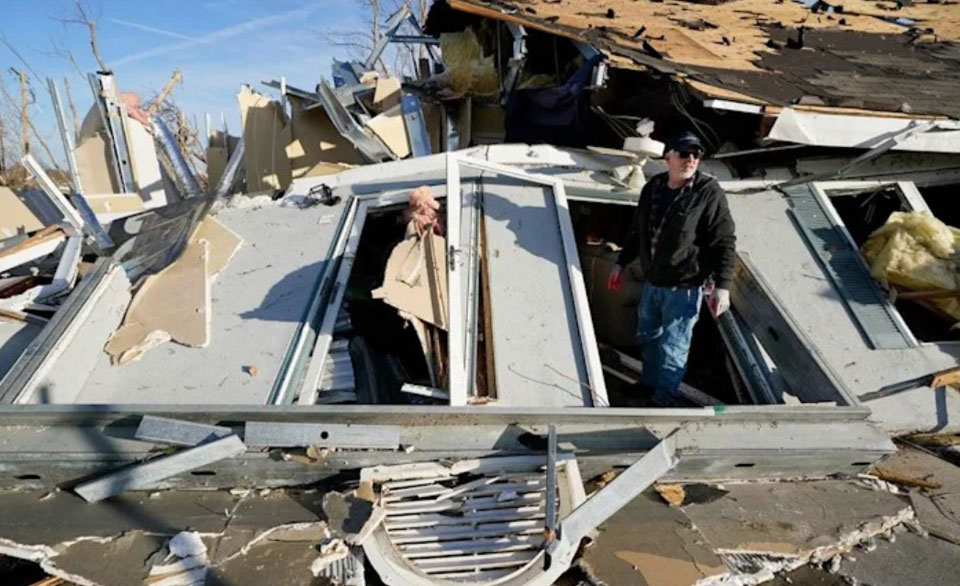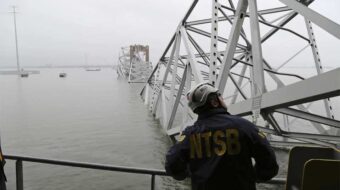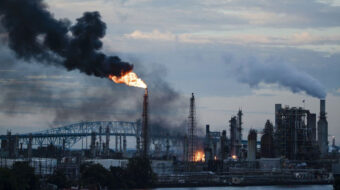
WASHINGTON—Is there a connection between global warming and the devastating tornadoes that killed dozens of people and flattened at least one entire Kentucky town, plus an Amazon warehouse in downstate Illinois, on Dec. 10-11?
The scientists’ answer, going all the way back to 2019, if not before: Yes, but it’s indirect.
The reason for the uncertainty, climatologists at the National Oceanic and Atmospheric Administration, Stanford University, and Northern Illinois University, told the Washington Post, the Pacific Standard, and other media, is that while global warming definitely causes more severe weather and more frequent high-velocity storms, it can’t be linked to specific tornadoes—such as the ones that cut a swath of hundreds of miles through five states.
“It looks like a war zone out there,” Gov. Andy Beshear of Kentucky, the hardest-hit state, told President Joe Biden over the telephone.
“More unpredictable weather can be expected countrywide as rising temperatures result in unseasonable–and unprecedented–weather patterns,” AP and CNN reported. The links are specific to heat waves and droughts, not to tornadoes, yet.
That’s because atmospheric conditions, including higher temperatures, higher humidity, and wind shifts, produce the possibility of more tornadoes, but not the certainty. But research hasn’t advanced far enough to link specific storms to global warming, scientists cautioned.
Biden agrees. He made that connection in answering a reporter’s question after he announced a disaster declaration for Kentucky. “All that I know is that the intensity of the weather across the board has some impact as a consequence of the warming of the planet and the climate change,” the president said.
“The specific impact on these specific storms, I can’t say at this point. I’m going to be asking the EPA and others to take a look at that. But the fact is that we all know everything is more intense when the climate is warming—everything. And, obviously, it has some impact here, but I can’t give you a quantitative read on that,” he said on Dec. 11.
“We’ve been observing temperature objectively for a long time with networks of thermometers and weather balloons and then satellites,” Stanford earth system science professor Noah Diffenbaugh told The Pacific Standard news and science website in 2019. “Tornadoes are harder to observe remotely.”
What can be linked, the scientists add, is the Earth’s rising temperature due to global warming to a whole long list of catastrophes, from melting icebergs in the Arctic to rising sea levels inundating Miami Beach to thawing tundra in Alaska to the raging wildfires which have swept drought-stricken California, Arizona and other parts of the U.S. west for the last several years.
That includes more tornadoes outside the traditional “Tornado Alley” of the Midwest. In 2018, for example, Connecticut led the nation in reported tornadoes, with nine.
The past weekend’s twisters roared through northeast Arkansas, southeast Missouri, northwest Tennessee, southern Illinois, and western Kentucky, hurling debris into the sky for more than three straight hours, newspapers and news services reported.
And in those local areas, the media added, temperatures, pre-tornadoes, reached into the 70s.
News services reported that sometimes the wreckage reached an altitude of 30,000 feet. The death toll could be as high as 64, and it would have been worse had not authorities in the most-devastated town, Mayfield, Ky., found that only eight workers—not the full force of 110—were inside a destroyed candle factory. Eight others are missing.
The Mayfield tornado sheared roofs off houses and some houses off their foundations. Kentucky’s lieutenant governor said search-and-rescue teams were going house-to-house seeking survivors—except that sometimes all they found were foundations.
Another multiple death toll, six, occurred in Edwardsville, Ill. The tornado there destroyed an Amazon warehouse. The Edwardsville Intelligencer reported local officials and residents were peeved at the tardy reaction by Amazon founder Jeff Bezos, one of the nation’s two richest people, to the tragedy.
Bezos, the paper said, spent his time on social media on Dec. 11 discussing the latest space mission his firm sponsored. Only late that day did he offer “thoughts and prayers” for the tornado victims and their families. He said Amazon would support the victims and survivors but didn’t say how.
In that 2019 article, scientists at the National Oceanic and Atmospheric Administration and Northern Illinois University told Kate Wheeling of the Pacific Standard about a prior study, using data from 1979-2018, that showed the number of tornadoes stayed relatively constant over time, but “Tornado Alley” shifted eastwards.
There were fewer twisters in Texas, Oklahoma, Colorado, and Kansas and more in Illinois, Missouri, Mississippi, Alabama, Arkansas, Tennessee, and Kentucky.
But the real impact of tornadoes was not in the number of or frequency of the storms, but in the damage they cause—simply because “we have more targets” for tornadoes to hit than in prior years, Northern Illinois University climatologist Victor Gensini, lead author of the study, said then.












Comments